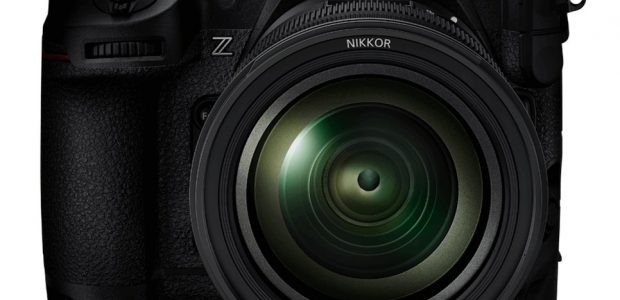By Ralf Lange
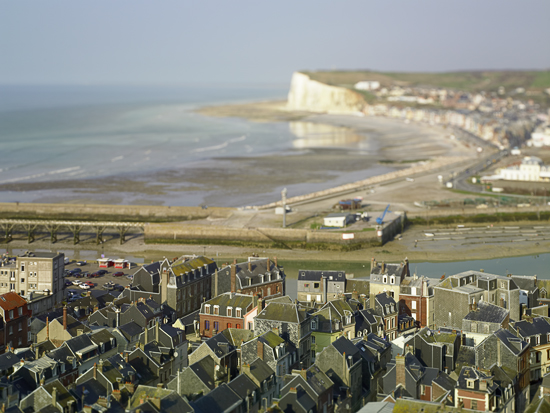
Le Treport – France, February 2005
Phase One 25 mm with Arca Swiss, Apo-Sironar digital 90 mm, f5.6, and ISO 50
A short while ago I went on a one-week photo trip to Poland. Because I was not sure which of my cameras would suit me best I decided against all reason to lug the entire collection with me and test the load limit of my station wagon with my Canon, my Contax, and my Arca Swiss. To my surprise it was the view camera which in the end yielded 12 of the 15 quality photos. Of course, any statistic of this sort always depends on the motive – sports and action photographers need not read further at this point. Chances are that those of you who predominantly use a tripod and/or shift lenses on 35mm and medium format cameras have also pondered the pros and cons of a view camera in the past. While most photographers still associate a view camera exclusively with a studio environment, recent developments allow the use of view cameras on the go with ease. This is made possible through the recent addition of wireless digital backs to the market, which can be fitted to light-weight view cameras without difficulty.
________________________________________________________________________
How it used to be
Traditional, film-based large format photography is cumbersome and expensive. Due to the heavy weight equipment and the considerable costs for film material and development this style of making photos has always been limited to professionals and physically fit enthusiasts. Some architectural photographers prefer the less expensive, and more mobile, 6×9 cm format on roll film. Here, though, mobility comes at the price of somewhat lesser picture quality. Also, finding a really good laboratory is becoming increasingly difficult, and the variety of suitable films is decreasing.
________________________________________________________________________
Are tilt/shift lenses a viable alternative?
There are occasions where I still make photos using Canon-brand tilt/shift lenses. Yet due their many restrictions I have never become a real fan of this type of lens. Compared to a view camera, tilt/shift lenses allow less lens movement (restricted to appr. 10 mm) and can only be shifted horizontally or vertically. In addition, picture quality (to my eye) is somewhat unsatisfactory, especially with regard to wide-angle shots. A view camera, by contrast, comes with lenses that in their entirety offer wide-ranging control of perspective and sharpness of image. New generation optics by Rodenstock and Schneider made especially for digital photography define the state of the art, and photos taken using these lenses are virtually free of distortion.
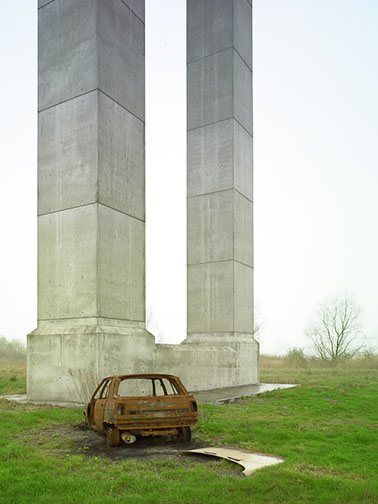
Viaduct spanning the Grand Canal du Havre in France, February 2005
Phase One 25 mm with Arca Swiss, Apo-Sironar digital 45 mm, f4.5, and ISO 50
________________________________________________________________________
Which back makes the cut?
It can be assumed that all 22-megapixel backs available on the market today offer comparable image quality, as can be seen from numerous test reports (also on this website). There are, however, significant differences with regard to their suitability for mobile use. The clear winner in this category – at least for the time being – is Phase One’s P25 with completely wireless operation.
________________________________________________________________________
Which view camera?
I have taken a close look at a whole range of view cameras. In terms of mobile digital use, 4×5 inch cameras are suited – if at all – only for those who already own one and would like to step up to digital photography. Phase One’s flexadapter is obviously aimed at this particular target group, as it allows back-and-forth movement between the ground glass and the back on the 4×5 carrier. Those in the market for a new camera, on the other hand, ought not spend too much time looking into a camera that is designed for a much larger format. 6×9 cm is by far the better format. I was able to test the current crop of models from Sinar, Linhof, Plaubel and Arca Swiss, and here is what I found:
– Sinar’s p3 is designed primarily for studio settings, using electronic shutters and PC linkage. A laptop is used to determine focus and subject area via a 1 fps “live picture” generated by an LC shutter. While it may be somewhat complicated, this method offers unsurpassed precision. Focal lengths up to 45 mm function well while offering adequate adjustment options. Outside the studio, on the go, this camera will not allow the use of wide-angle lenses if one plans to use ground glass instead of a live picture for focusing. This is because the lens and the sensor simply cannot be brought together close enough for infinity focusing due to the thickness of the carriers.
– Linhof’s M 679cc turned out to be antithetical to my work style. It allows only minimal direct shifting at the rear carrier via knobs that are located behind the sliding adapter and which are nearly inaccessible. This camera is clearly designed for photographers who prefer indirect shifting.
– Marketed as “digitally compatible” because of its narrow standards, the 6×9 Plaubel PL69D camera weighs 4.5 kg and requires a Hasselblad adapter.
– The equally very narrow Arca Swiss f-metric scores on weight (2.1 kg!) and compatibility, as it can be used not only with Hasselblad, but also with Contax adapters.
________________________________________________________________________
P25 @Arca Swiss in use

Arca Swiss f-metric 6×9 with Phase One P25
I have been using the P25 on Arca Swiss’ f-metric 6×9 since March. To say it right away: this setup thrilled me the most, save for a few limitations. It can easily be stored in a medium-size bag, and you don’t need to see your orthopedic surgeon after a long outing on foot. A light-weight tripod will do – I prefer the Gitzo 1227 LVL (http://www.gitzo.com) along with the Manfrotto 410 geared head (http://www.manfrotto.com/product/templates/templates.php3?sectionid=10&itemid=278). The complete camera with objective lens and back comes in at 3.3 kg – not bad if you consider that my Contax 645 with lens and back weighs 2.7 kg.
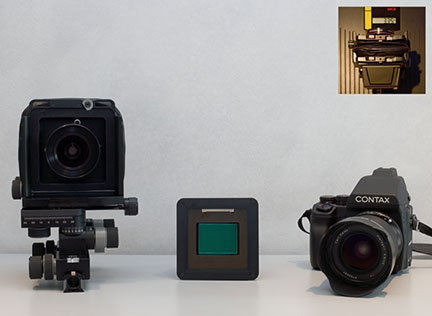
Complete with objective lens and back the Arca Swiss weighs a mere 3.3 kg and has surprisingly small dimensions.
You can use a wide-angle bellow for focal lengths of up to 90 mm.
As regards objective lenses I favour mechanical shutters – in my opinion the electronic variety is next to superfluous and expensive to boot. And yes, you still need one small sync cable to connect the lens to the back.
The system can be assembled in less than a minute. Leveling is achieved best with the help of geared movements and a pair of spirit levels. With regard to focusing on the ground glass I use a magnifying glass with 4x magnification. In situations where the ambient light is too bright I simply put a jacket over the camera.
Another neat aspect of this setup is the P25’s preview feature, which allows me to make changes to the exposure setting or even resize the subject area without having to remount the ground glass. It also saves me the hassle of having to deal with the drawbacks of a sliding adapter (see below).
Unfortunately there is no truth to the adage that large-format photography is a rather contemplative affair, akin to fishing. On the contrary, in the past I often found my wrangling with heavy and difficult-to-assemble cameras to be more taxing than relaxing. Moreover, the fact that the right moment and the right light always last only for the blink of an eye also applies to large format photography, and the chances of getting that lucky shot with a cumberome camera are pretty low. With this in mind I must say that I am quite happy with the aforementioned setup. It does the job. If required, I can take a picture within two minutes – which suits me fine.
________________________________________________________________________
The problem with wide-angle lenses
When it comes to combining digital backs with view cameras, one of the biggest problems lies in the difficulty of bringing lens and back together close enough for wide-angle shots, due to the small sensor format. Arca Swiss offers both a regular and a sliding adapter.
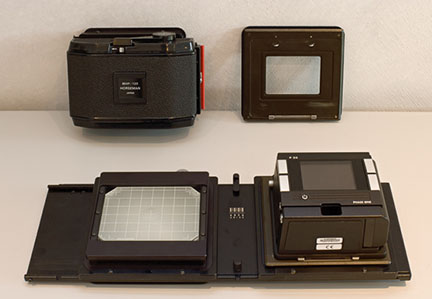
Bottom: Sliding adapter with ground glass and back.
Top right: Contax insert for direct coupling of the back to the view camera.
Top left: A roll film cassette can also be used anytime.
The problem associated with using a sliding adapter lies in fact that it enlarges the distance to the lens. Already with a 45 mm lens a sliding adapter will curtail its functional range; if you wish to shift more than 10 mm the bellow will move the standards apart when set to infinity. Without a sliding adapter, shifting distances of 25 mm and more become possible. With lenses of greater than 45 mm focal length there are no limitations whatsoever. To me, sliding adapters are quite superfluous as I have gotten completely used to working without them in recent months. Instead I attach the back to the rear carrier using the “standard” Contax insert. There is a small chance of dirt falling on the sensor during the moment when the cover is removed and the back is attached to the camera, especially in cases of strong wind or a dusty environment. This has never been a bother for me, as the occasional piece of dust on the chip can easily be removed with a blowbrush.
I take most of my pictures with a 45 mm or 90 mm lens. Occasionally I do miss a true wide-angle lens, and it looks like as if Schneider Kreuznach (http://www.schneider-kreuznach.com/index_e.htm) is going to answer my prayers with the market launch of their new line of wide-angle lenses (ranging to 24 mm!) after the summer holidays. According to informed sources (http://www.digitar.alpavision.ch/) they have been specially designed with the problems of digital view cameras in mind. However, one can always resort to a roll film cassette for extreme wide-angle shots. Whenever I tried out “digital” labeled lenses they always worked fine also using film, and vice versa.
________________________________________________________________________
Conclusion
Modern, wireless digital backs are a perfect match for light-weight 6×9 format view cameras. A setup of this kind is not necessarily much heavier than 35 mm or medium format equipment, and yet it offers optimum image quality and control of perspective when it comes to architectural and landscape photography. Their sole drawback is a somewhat reduced wide-angle capability, which is due to the small sensor format compared to film. Let’s see what the future holds in this regard, both in terms of sensor development (larger formats, anyone?) and new lenses.
Oh yes, I almost forgot: On my next trip I will leave the Contax and all my shift lenses at home, supplement my Arca Swiss with the extremely flexible Canon, and throw in a standard and a telescopic zoom lens for good measure. Or I may decide to take everything with me, again.

Gdansk – Poland, July 2005
Phase One 25 mm with Arca Swiss, Apo-Sironar digital 45 mm, f4.5, and ISO 50
________________________________________________________________________
Dr. Ralf Lange lives in Germany and works as a cardiologist (www.kardiologie-gladbeck.de).
He has been a passionate photographer for many years (www.osx.li).
You May Also Enjoy...
More – Understanding Resolution
One of my Understanding Series articles is titled Understanding Resolution. This has proven to be very popular among visitors to this site, as it attempts to address some
Of the Nikon Z9 and other new and upcoming gear
FacebookTweet Nikon recently released the first development announcement for their new flagship mirrorless Z9. We don’t know much about it officially, and the rumor mill
